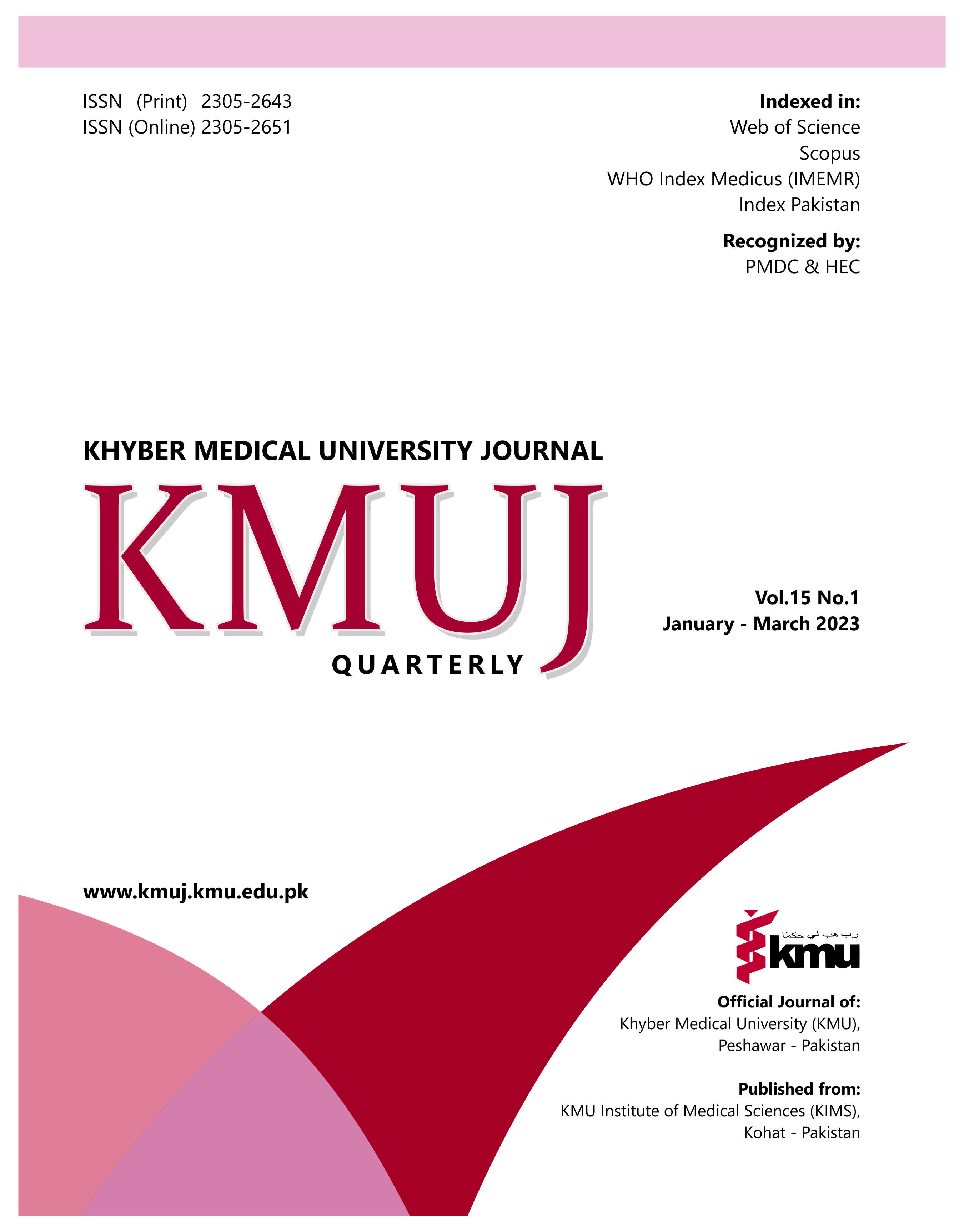ASSESSING STAFF REQUIREMENTS AND WORKLOAD PRESSURE AMONG DOCTORS WORKING IN OBSTETRICS & GYNECOLOGY DEPARTMENT OF A PUBLIC SECTOR HOSPITAL IN PAKISTAN USING THE WORLD HEALTH ORGANIZATION’S WORKLOAD INDICATORS OF STAFFING NEEDS
Main Article Content
Abstract
OBJECTIVE: To assess the doctors’ requirement/workload pressure in Department of Obstetrics and Gynecology (DObGyn) of a public sector hospital for effective planning and management of human resources.
METHODS: World Health Organization's Workload Indicators of Staffing Needs (WISN) tool was used in assessing the staffing requirements for doctors working in the DObGyn of a public sector hospital Khyber Pakhtunkhwa, Pakistan. Information on working conditions and staffing was acquired by reviewing relevant documents and interviewing key informants. We obtained workload statistics from the hospital from January 1 to December 31, 2015. We assisted a senior technical expert working group in identifying workload components and activity standards, as well as validating both.
RESULTS: The average working time needed by the doctors to perform ‘health service activities' was 1952 hours, for which 32 doctors are needed, while there are 36 doctors in the department. ‘Support activities’ accounted for about a fifth of the doctors' annual working hours (-category allowance standards=18.54%), for which 7 doctors were additionally needed. The ‘additional activities' required 3566 hours for which 2 additional doctors were needed. To perform all the three activities, there was a total need of 41 doctors. The workload pressure was also found to be high (WISN ratio: 0.87) on doctors.
CONCLUSION: The health services, support and additional activities take up about significant part of the doctors’ time annually. This may require recruitment of a low-cost skill-mix of healthcare personnel to cope with the current workload and/or a health system thinking perspective to reduce the workload indirectly.
Article Details
Work published in KMUJ is licensed under a
Creative Commons Attribution 4.0 License
Authors are permitted and encouraged to post their work online (e.g., in institutional repositories or on their website) prior to and during the submission process, as it can lead to productive exchanges, as well as earlier and greater citation of published work.
(e.g., in institutional repositories or on their website) prior to and during the submission process, as it can lead to productive exchanges, as well as earlier and greater citation of published work.
References
Miseda MH, Were SO, Murianki CA, Mutuku MP, Mutwiwa SN. The implication of the shortage of health workforce specialist on universal health coverage in Kenya. Hum Resour Health 2017;15(1):80. https://doi.org/10.1186/s12960-017-0253-9
Chemali Z, Ezzeddine F, Gelaye B, Dossett ML, Salameh J, Bizri M, et al. Burnout among healthcare providers in the complex environment of the Middle East: a systematic review. BMC Public Health 2019;19(1):1337. https://doi.org/10.1186/s12889-019-7713-1
Joarder T, Tune SNBK, Nuruzzaman M, Alam S, de Oliveira CV, Zapata T. Assessment of staffing needs for physicians and nurses at Upazila health complexes in Bangladesh using WHO workload indicators of staffing need (WISN) method. BMJ Open 2020;10(2):e035183. https://doi.org/10.1136/bmjopen-2019-035183
Khan SA. Situation analysis of health care system of Pakistan: post 18 amendments. Health Care Curr Rev 2019;7(3):244. https://doi.org/10.35248/2375-4273.19.07.244
Abdullah MA, Mukhtar F, Wazir S, Gilani I, Gorar Z, Shaikh BT. The health workforce crisis in Pakistan: a critical review and the way forward. World Health Popul 2014;15(3):4–12.
Hafeez A, Khan Z, Bile KM, Jooma R, Sheikh M. Pakistan human resources for health assessment, 2009. East Mediterr Health J 2010;16 Suppl:S145-51.
Schofield D, Fletcher S, Fuller J, Birden H, Page S. Where do students in the health professions want to work? Hum Resour Health 2009;7(1):74. https://doi.org/10.1186/1478-4491-7-74
Saini NK, Singh S, Parasuraman G, Rajoura O. Comparative assessment of satisfaction among outpatient department patients visiting secondary and tertiary level government hospitals of a district in Delhi. Indian J Community Med 2013;38(2):114-7. https://doi.org/10.4103/0970-0218.112449
Government of Khyber Pakhtunkhwa. Department of Health. Khyber Pakhtunkhwa Health Sector Strategy 2010 – 2017. [Accessed on: February 07, 2023.] Available from URL: http://healthkp.gov.pk/public/uploads/downloads-42.pdf
Zaidi SA, Bigdeli M, Langlois EV, Riaz A, Orr DW, Idrees N, et al. Health systems changes after decentralisation: progress, challenges and dynamics in Pakistan. BMJ Glob Health 2019;4(1):e001013. https://doi.org/10.1136/bmjgh-2018-001013
Shaikh BT. Strengthening health system with key strategies in the post devolution times in Pakistan. Pak J Public Health 2012;2(2):43-6.
Asian Development Bank. Khyber Pakhtunkhwa Health Sector Review: Hospital Care. Asian Development Bank; 2019. [Accessed on: January 1, 2022]. Available from URL: https://www.adb.org/publications/khyber-pakhtunkhwa-health-review-hospital-care
Kamal Z, Aleem M, Aziz N, Amjad HM. Medical Teaching Institutions Reforms Act: Facts and Fictions. Pak J Med Sci 2021;37(5):1252–3. https://doi.org/10.12669/pjms.37.5.4551
Law & Parliamentary Affairs Department, Government of Khyber Pakhtunkhwa. Khyber Pakhtunkhwa Code. Medical Teaching Institution (MTI) Reforms Act in 2015. [Accessed on: February 07, 2023.] Available from URL: https://kpcode.kp.gov.pk/homepage/lawDetails/838
World Health Organization. Workload indicators of staffing need:2010. [Accessed on January 1, 2022]. Available from URL: https://apps.who.int/iris/bitstream/handle/10665/44414/9789241500197_users_eng.pdf
World Health Organization. Applying the WISN method in practice: case studies from Indonesia, Mozambique and Uganda;2010. [Accessed on: January 1, 2022]. Available from URL: https://apps.who.int/iris/handle/10665/44415
Satish N, Arif S, Bhaskar NK, Satyanara N. Gap analysis in staffing using workload indicators of staffing need method in a tertiary care teaching hospital. Int J Sci Res 2015;4(7):376–7. https://www.doi.org/10.36106/ijsr
Erickson SM, Rockwern B, Koltov M, McLean RM, Medical Practice and Quality Committee of the American College of Physician. Putting patients first by reducing administrative tasks in health care: a position paper of the American College of Physicians. Ann Intern Med 2017;166(9):659–61. https://doi.org/10.7326/m16-2697
Hagopian A, Mohanty MK, Das A, House PJ. Applying WHO’s ‘workforce indicators of staffing need’(WISN) method to calculate the health worker requirements for India’s maternal and child health service guarantees in Orissa State. Health Policy Plan 2012;27(1):11–8. https://doi.org/10.1093/heapol/czr007
Nyamtema AS, Urassa DP, Massawe S, Massawe A, Lindmark G, Van Roosmalen J. Staffing needs for quality perinatal care in Tanzania. Afr J Reprod Health 2008;12(3):113-24.
Ghafoor Y, Yaqoob A, Bilal A, Ghafoor S. Impact of Nurse Shortage on Patient Care. Saudi J Nurs Health Care 2021;4(4):114–9. https://doi.org/10.36348/sjnhc.2021.v04i04.003
Doosty F, Maleki MR, Yarmohammadian MH. An investigation on workload indicator of staffing need: A scoping review. J Educ Health Promot 2019;8:22. https://doi.org/10.4103/jehp.jehp_220_18
